I liked my original idea. I still do. It was going to be a machine-knit version of a felted, dropped-stitch scarf pattern called “Les Miserables,” which has a deconstructed look that attracts me, but not enough to suffer through hand-knitting all that stockinette. After machine-knitting it and gently felting it, I was going to fold it up shibori-style and put it into some dark blue acid dyes and hopefully get rectangular patterning amid the lacy laddering. I got a cone of lovely feltable, undyed wool from the Yeoman Yarns company in the UK, and whipped up a swatch on the machine. It felted beautifully and the dropped stitch ladders had the exact deconstructed look I was going for. I folded the swatch tightly into triangles and wrapped a rubber band around it. I put citric acid into the bath, put in the swatch, poured in a mixture of cyan and black, and heated the bath as gently as I could so as not to felt my swatch further. This is the swatch. I swear I didn’t skin a tiny mutant rat after stabbing it to death multiple times.

Clearly I had mishandled the acid dyes, which I had never used before, and despite my precautions, I nevertheless felted the swatch more than I had intended. So I knitted up a length of the feltable yarn on the machine, 120 stitches wide and 800 rows long on tension setting 8, without the dropped stitches. It was enormous and diaphanous. Then I hand-felted it, trying to keep the edges from folding in on themselves excessively by pulling outward on the edges, which put ruffles into the shape. There was a lot of scarf there, and it was wet and unwieldy, so I couldn’t tell how large or what shape my fabric was becoming. The consistency felt pretty good, but I didn’t want it to felt further. I decided to see what would happen if I used natural dyes that I was storing in the refrigerator, some avocado exhaust bath and some mulberries that I had just boiled, and put the felted scarf into an unheated bath in hopes that it wouldn’t felt more. My idea was to dye it in the mulberry until it turned pink, and then fold it up and bind it in lengthwise folds with rubber bands. The trick was to mordant the scarf without felting it, so I gently heated the scarf in an alum and cream of tartar mordant, taking care to keep the mordant below boiling temperature. Steam, no bubbles.
The Fiber Goddess didn’t go along with any of this. Not one detail.
First, she nixed the dyeing. I’m used to dyeing with Wollmeise lace yarn, a superwash yarn that takes natural dyes very readily. Here I was working with a feltable (and therefore not superwash) yarn. Superwash processing makes wool more receptive to absorbing dyes, and yarns that haven’t been subjected to superwash processing tend to take on less dye color, as I was about to learn the hard way. I got a faint pink tint from the mulberry bath.

I had hopes for the avocado skin exhaust bath, since it had been very potent and I thought it might have enough juice left to produce some contrast with the light pink in a shibori fold. Folding the scarf was awkward, because it was very long and no longer a real rectangle as a result of the gentle felting it had undergone. But I folded it the best I could and bound the folds in the same rubber band I’d used for the ratskin pelt swatch, which still had some color from its time in the blue and black acid dye.

That dye bath might look like a nice deep brown, but it you wouldn’t know it from the amount that was absorbed in the scarf, which was none. The only color that transferred to the scarf was the dye that was still in the rubber band from the swatch. If you look closely at the knitting in the two pictures above, you can see that the consistency of the fabric changed drastically from the upper one of the two to the lower one. I didn’t shock the fabric with drastic temperature changes, but I must have over-handled the wet fibers while attempting that ill-fated shibori fold, because it went from lightly felted to heavily felted.
I rinsed it out as gently as I could, but I pulled the edges pretty hard to see if I could get more width and length from the scarf. As for its color, it was mostly a pale pink with faint bluish-greenish splotches mottling the pink. I let it dry, and it had a soft Velveteen Rabbit texture. It was long enough to wrap around my neck a few times. Interestingly, it wanted to fold in on itself in a crescent shape, with ruffles around the edges. Then the Fiber Goddess spoke to me.

Here’s the transcript of my conversation with the Fiber Goddess:
Me: Well, this isn’t what I expected.
Fiber Goddess: You’re not complaining, are you?
Me: Moi? Never, Fiber Goddess!
Fiber Goddess: Look at the pretty shawl shape and those flattering ruffles. You’re welcome!
Me: Yes, it’s surprisingly nice.
Fiber Goddess: Damn right it’s nice. It’s my gift to you. The ruffles will help you out with your neck, which isn’t what it used to be, dear. The pastel coloring will be a nice backdrop for that needle felting you’ve been thinking about.
Me: You’re so right, beneficent Fiber Goddess! Thank you!
I didn’t really appreciate the Fiber Goddess’ catty comment about my neck, but I let it pass because she had given me a generous and unexpected gift. I started thinking about all my old yarn stash, feltable non-superwash yarn in every color and weight, that I wouldn’t be able to knit because it had degraded with time and careless storage. But it could be needle felted. I envisioned swirls, flowers, and geometrics using my old yarn.
I couldn’t do anything more with this project for a few weeks because the next day we were flying to Norway for a week, and this wouldn’t be a good travel project. Too many separate bits and balls of yarn to keep track of, and I didn’t have felting needles. But I did change my plan for my felting materials because we went on a day trip to the Rauma yarn factory, where I found a bin full of small bags of colored roving in colors that are typical in Norwegian national costume, the bunad.
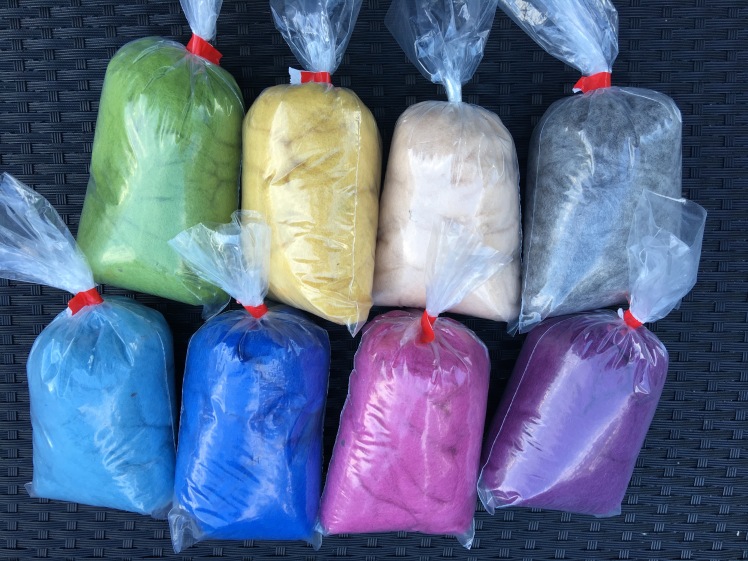
And just because I can’t resist, here’s the scenery right outside the door of the Rauma yarn factory.

When I got back home, pretty much my first stop was to my LYS to buy a needle felting starter kit, consisting of four felting needles and a foam block. I’d never needle-felted before, but it was pretty self-explanatory. You put your fabric over the foam block, and the fiber on top of the fabric in the shape you want to make, and you poke the needle through the fiber, through the fabric, and into your foam block. You keep poking until the fiber is firmly affixed to the fabric and the pieces of fiber are affixed to each other. The needle makes a satisfying crunchy sound when it goes in and out of the foam block. Sort of like the crunch of potato chips.
I started the needle felting about 10 days after coming home from Norway, which was the nicest place I’ve ever been. Coming back to the U.S. was a rough reentry. I still had Norway on my mind when I began making leaves and flower petals that had the feel of the embroidery on Norwegian bunads. The flowers were pretty, and they taught me the basics of needle felting (and there isn’t much more than basics in needle felting), but they didn’t feel right as a design feature. They were too derivative of Norway’s cultural heritage, which Norwegians take very, very seriously. I didn’t want to appropriate parts of a heritage that isn’t mine, and I felt tight and cramped and inhibited when I made my first motifs.
I started playing with circle and ring shapes, placing circles on top of circles, and something started to click. The bright and clear colors were a little bit dissonant together in a way that recalled past eras, and I began thinking of comic books from my childhood. Then I began thinking about 60’s pop kitsch and cheesy science fiction movies of the 50’s and 60’s. I began thinking of Barbarella, minus poor Jane Fonda being eternally humiliated by Roger Vadim, focusing instead on the candy colors and stylized shapes of that movie set world. Now I felt at home in my medium because I was creating a world and telling a story in a way, of planets and space ships and solar systems built on paisleys. It was huge fun to roll tiny bits of roving up into balls or wind it into twisted ropes and stab them into the scarf. Maybe not so much fun when I stabbed my fingers as well, but the pain was momentary. The roving and the technique lent itself readily to texture, which I used a lot especially with the pale peach pink roving that was almost the same color as the fabric, enabling me to use shadow as a design element.

I was also able to get nice effects from the roving by spreading it fiber by fiber across my motifs, or spreading it thinly across the fabric as a first layer, to make it look like gases or mist. I made the tiny dots by licking my fingers and rolling a couple of fibers together between them until the fibers balled up together, then speared the ball onto the end of my needle and stabbed it into the fabric. Tiny dots were very important to this design. So were medium sized and big dots.


I was really grateful to the Fiber Goddess for the way she placed the fold so that the top layer gave the lower layer an inch or so to get ruffly and gave me a little more space for embellishment. Bubbles, planets, tiny Milky Ways in different colors.
At the end I needed to find a way to integrate the terrestrial flowers with the extraterrestrial journey the rest of the piece was on. In the empty space next to the Norwegian-influenced flowers that initiated the piece, I started the transition from earth to outer space with a tightly wound spiral in the light blue of the earth’s atmosphere. Spirals seem very cosmic to me. Then I made some yellow flame shapes and arranged them around the circumference of the spiral, like flower petals. Or maybe like paisleys without the decorations. When the light blue spiral unwound for its wanderings past the earth’s atmosphere, I mixed dark blue fibers into the light blue rope and let the dark blue rope perambulate around the universe for a while.

When it was about to arrive at Barbarella’s universe, I phased out the dark blue and twisted dark purple into the rope, where it took a few loops around and turned into a planet. Or maybe into a scary sci-fi eye, like something on Star Trek.

As for filling the space at the opposite end of the scarf, I turned to my favorite motifs, paisleys and tiny dots. I placed paisleys around a spotted sun in an arrangement that echoed the flowers. Or maybe it’s a pinwheel. The motif connects with the planetary bodies through vapor trails of dots.

The reverse side is a blurry, soft-focus version of the front side. I think it’s visually pleasing.
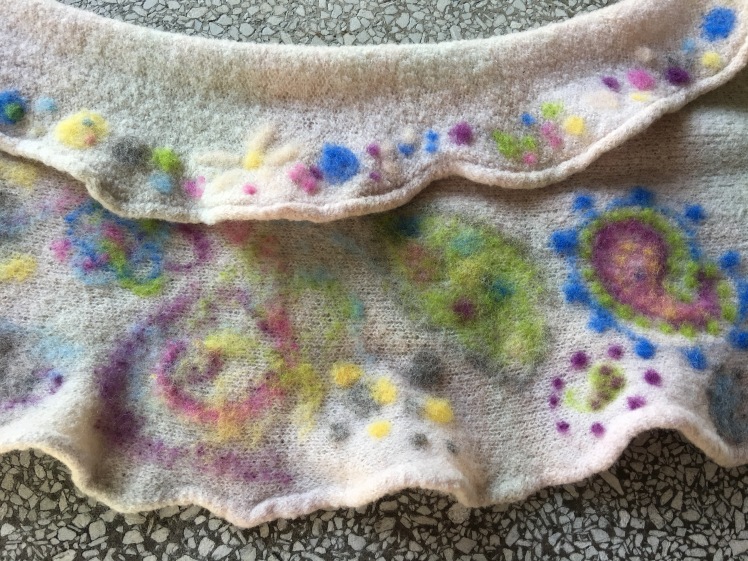
Every evening while I was working on the needle-felting, I would stand in front of a mirror and find different ways to wear the scarf and display its motifs. I found yet another thing to thank the Fiber Goddess for, the pointy ends at the corners of the scarf, which provided a tidy and secure way to tie the scarf in place when I wrapped it around my neck in a way that showed off its layers and ruffles. The Fiber Goddess was right, the ruffles are indeed kind to my neck.
This is my daughter modeling some of the ways this scarf can be worn.

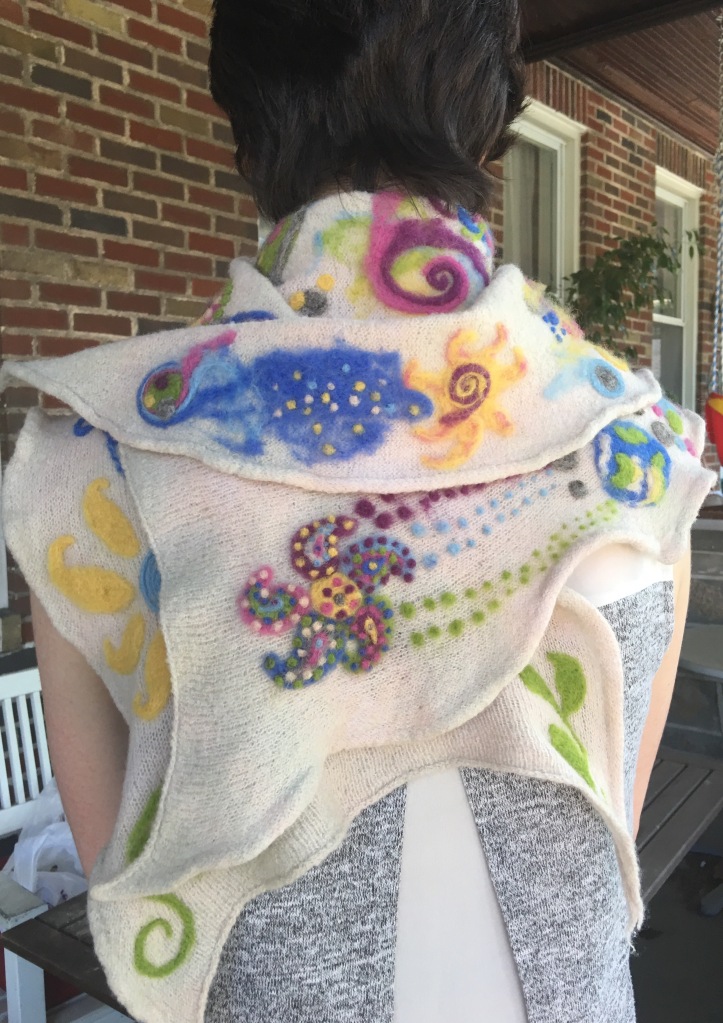

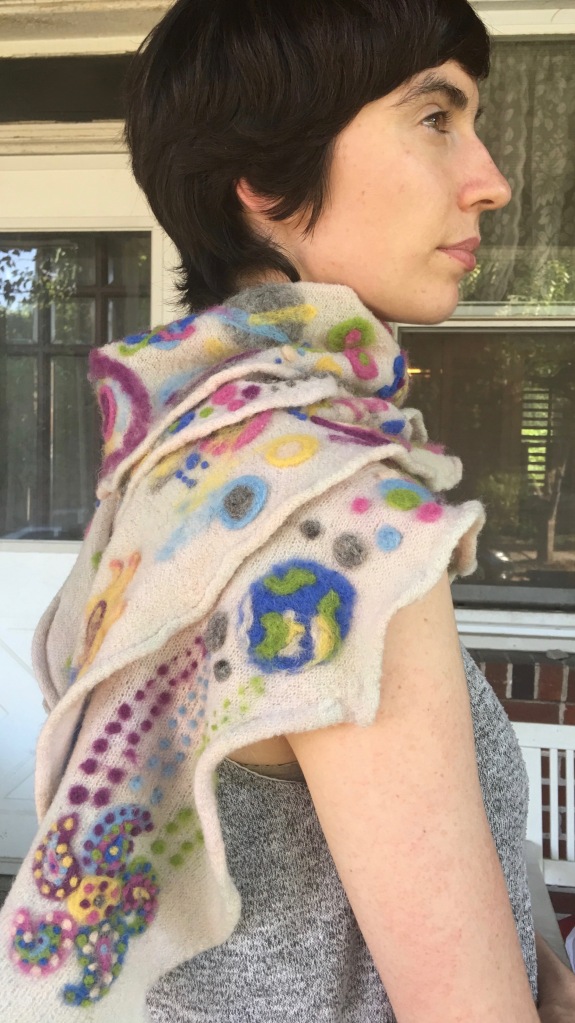


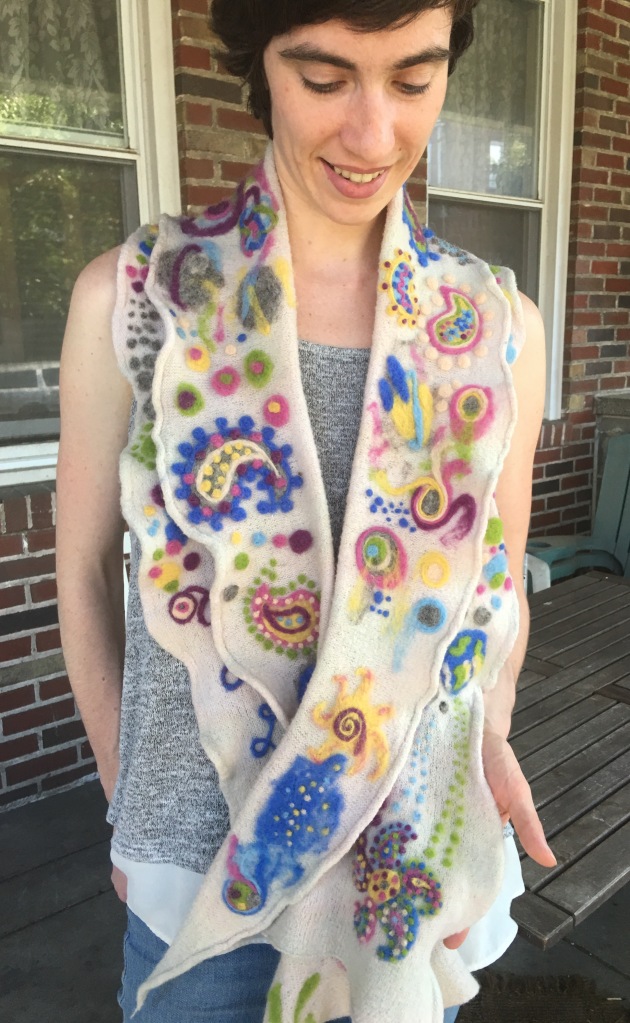

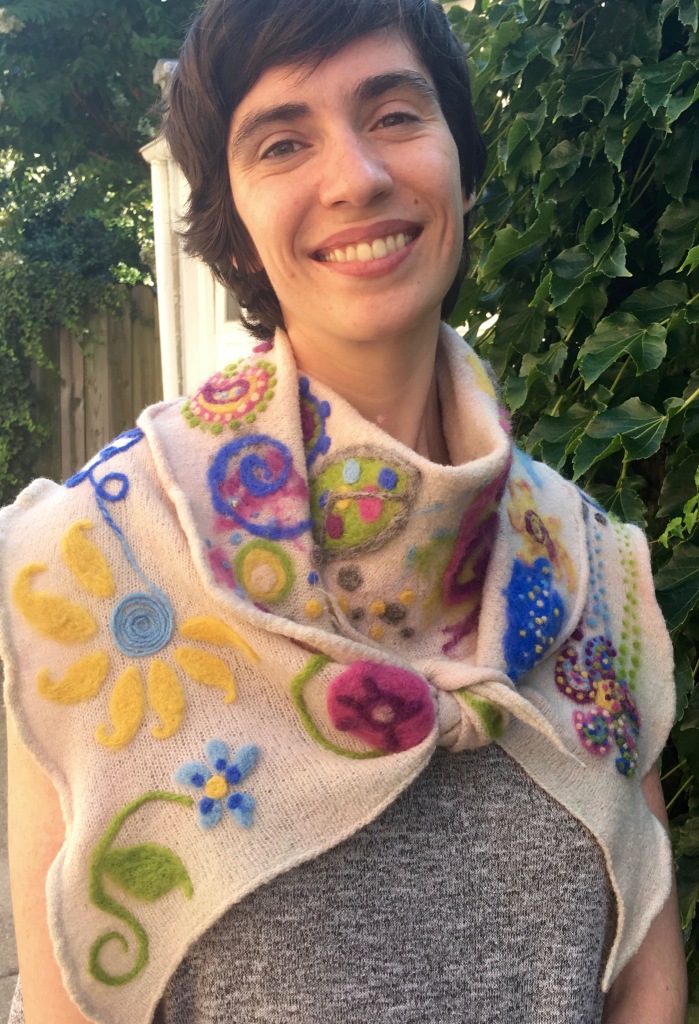

I think I understand why the Fiber Goddess felt I had gone so wrong that she had to intervene to save me from myself. There were several points of failure. First, I shouldn’t have felted the scarf before I dyed it. Second, my dye baths weren’t potent enough to give me the effects I sought using the non-superwash yarn. Third, my felted fabric was too unwieldy to achieve the crisp folds shibori dyeing requires to produce the contrast that will reveal the design. Fourth, I had handled the wet fabric too much in the course of all these processes to achieve the degree of felting I was planning and instead produced a much more densely felted fabric. But I had given the Fiber Goddess enough fabric to work with for her alternative plan, and I was wise enough to listen to her when she spoke to me.

This might be my favorite of your projects, and blog posts, yet. Your ingenuity and improvisational skills remind me of Mom, minus her unhinged aesthetic sense. And your model is very lovely. She was made for short hair.
LikeLike
Thanks, Mandy! Mom certainly was ingenious and improvisational. And unhinged, glad to have not inherited that!
LikeLike
I love this project! So different from your most recent explorations, especially color wise. It inspires me to play with needle felting since I love embellishment so much. Even just the plain dots are fabulous. If only I could stand to knit enough stockinette…Maybe I will try it on something small like a hat. Wonderful! The Norwegian influence definitely shows even though it’s completely different. Glad your trip was so inspiring.
LikeLike
Stockinette makes me want to poke a needle in my eye just to relieve the boredom! The knitting machine is my solution to that problem.
LikeLike
I really love the final result of your scarf and I enyoyed your blog post very much. It’s a strange coincidence that these last couple of weeks, I also started with all kinds of felt experiments, nothing worth showing though, but I think I’m starting to like the whole felting process, we’ll see what happens next. Good work!
LikeLike
Thanks so much! I’m not done with this idea yet.
LikeLike